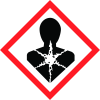Nickel (Ni) standard solution
Sigma-Aldrich Inc
Revision date : 2023-04-29

Note: Ingredients listed on restricted chemical lists
EC/CAS
236-068-5/13138-45-9
Name of the chemical
Nickel nitrate (2+ salt)
Concentration
>=3-<10
General Information
Version
6.12
Revision date
2023-04-29
Product name
Nickel (Ni) standard solution
REACH No
This
Emergency telephone
800-424-9300, +1-703- 527-3887
Icons in SDS
Company Information
Company name
Sigma-Aldrich Inc
GHS Information
Signal word
Danger
Hazard Codes
Hazard statements (CLP)
H290, H314, H317, H318, H334, H341, H350, H360, H372, H400, H410
Hazard statements
Code
Statements
H290
May be corrosive to metals
H314
Causes severe skin burns and eye damage
H317
May cause an allergic skin reaction
H318
Causes serious eye damage
H334
May cause allergy or asthma symptoms or breathing difficulties if inhaled
H341
Suspected of causing genetic defects
H350
May cause cancer
H360
May damage fertility or the unborn child
H372
Causes damage to organs through prolonged or repeated exposure
H400
Very toxic to aquatic life
H410
Very toxic to aquatic life with long lasting effects
Precautionary statements
Code
Statements
P202
Do not handle until all safety precautions have been read and understood.
P273
Avoid release to the environment.
P280
Wear protective gloves/protective clothing/eye protection/face protection.
P303+P361+P353
IF ON SKIN (or hair): Take off Immediately all contaminated clothing. Rinse SKIN with water [or shower].
P305+P351+P338
IF IN EYES: Rinse cautiously with water for several minutes. Remove contact lenses if present and easy to do - continue rinsing.
EUH-statements
Code
Statements
EUH071
Corrosive to the respiratory tract
Section 2
SECTION 2: Hazards identification
2.1 Classification of the substance or mixture
Classification
2.2 Label elements
Labelling
Signal word
Danger Danger
Hazard statements
H290 May be corrosive to metals. H314 Causes severe skin burns and eye damage. H317 May cause an allergic skin reaction. H334 May cause allergy or asthma symptoms or breathing difficulties if inhaled. H341 Suspected of causing genetic defects. H350 May cause cancer. H360 May damage fertility or the unborn child. H372 Causes damage to organs through prolonged or repeated exposure. H410 Very toxic to aquatic life with long lasting effects. H334 May cause allergy or asthma symptoms or breathing difficulties if inhaled. H317 May cause an allergic skin reaction. H341 Suspected of causing genetic defects. H350 May cause cancer. H360 May damage fertility or the unborn child. H372 Causes damage to organs through prolonged or repeated exposure. H314 Causes severe skin burns and eye damage.
Precautionary statements
P202 Do not handle until all safety precautions have been read and understood. P273 Avoid release to the environment. P280 Wear protective gloves/ protective clothing/ eye protection/ face protection. P303 + P361 + P353 IF ON SKIN (or hair): Take off immediately all contaminated clothing. Rinse skin with water. P304 + P340 + P310 IF INHALED: Remove person to fresh air and keep comfortable for breathing. Immediately call a POISON CENTER/ doctor. P305 + P351 + P338 IF IN EYES: Rinse cautiously with water for several minutes. Remove contact lenses, if present and easy to do. Continue rinsing. P202 Do not handle until all safety precautions have been read and understood. P280 Wear protective gloves/ protective clothing/ eye protection/ face protection. P303 + P361 + P353 IF ON SKIN (or hair): Take off immediately all contaminated clothing. Rinse skin with water. P304 + P340 + P310 IF INHALED: Remove person to fresh air and keep comfortable for breathing. Immediately call a POISON CENTER/ doctor. P305 + P351 + P338 IF IN EYES: Rinse cautiously with water for several minutes. Remove contact lenses, if present and easy to do. Continue rinsing.
Supplemental label elements
EUH071 Corrosive to the respiratory tract. Restricted to professional users. Reduced Labeling (<= 125 ml) EUH071 Corrosive to the respiratory tract.
2.3 Other hazards
This substance/mixture contains no components considered to be either persistent, bioaccumulative and toxic (PBT), or very persistent and very bioaccumulative (vPvB) at levels of 0.1% or higher.

